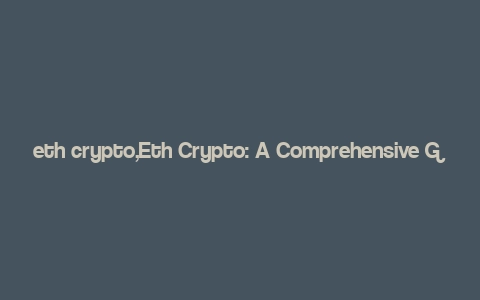Eth Crypto: A Comprehensive Guide for Understanding Ethereum and Cryptocurrency
Are you intrigued by the world of Ethereum and cryptocurrency? Do you want to delve deeper into the intricacies of blockchain technology and understand how it’s revolutionizing the financial industry? Look no further! This article will provide you with a detailed, multi-dimensional introduction to Ethereum and cryptocurrency, ensuring you have a comprehensive understanding of the subject.
What is Ethereum?
Ethereum is a decentralized platform that enables developers to build and deploy smart contracts and decentralized applications (DApps). It was created by Vitalik Buterin in 2015 and has since become one of the most popular blockchain platforms in the world.
Understanding Blockchain Technology
Before diving into Ethereum, it’s essential to understand the underlying technology: blockchain. Blockchain is a distributed ledger technology that allows for secure, transparent, and tamper-proof transactions. It consists of a chain of blocks, each containing a set of transactions, which are linked together in a chronological order.
The Ethereum Network
The Ethereum network is powered by its native cryptocurrency, Ether (ETH). Ether is used to pay for transaction fees and to incentivize miners to secure the network. The network is maintained by a network of nodes, which are computers that run the Ethereum software and participate in the consensus process.
Smart Contracts
One of the most significant features of Ethereum is its ability to support smart contracts. Smart contracts are self-executing contracts with the terms of the agreement directly written into lines of code. They run on the Ethereum Virtual Machine (EVM) and are immutable, meaning they cannot be changed once deployed.
Decentralized Applications (DApps)
Decentralized applications are applications that run on a decentralized network, such as Ethereum. They are built using smart contracts and are designed to be transparent, secure, and free from central control. DApps can range from simple applications, like a decentralized betting platform, to complex systems, like decentralized finance (DeFi) platforms.

Ethereum 2.0
Ethereum 2.0 is an upgrade to the Ethereum network that aims to improve scalability, security, and sustainability. The upgrade includes a transition from a proof-of-work (PoW) consensus mechanism to a proof-of-stake (PoS) mechanism, which will reduce energy consumption and make the network more energy-efficient.
Understanding Cryptocurrency
Cryptocurrency is a digital or virtual currency that uses cryptography for security. It operates independently of a central authority, such as a government or financial institution. The most well-known cryptocurrency is Bitcoin, but there are thousands of other cryptocurrencies, known as altcoins, available in the market.
The Role of Miners
In the context of Ethereum, miners are responsible for validating transactions and adding them to the blockchain. They are rewarded with Ether for their efforts. Miners use powerful computers to solve complex mathematical problems, which ensures the security and integrity of the network.
The Importance of Security
Security is a critical aspect of blockchain technology and cryptocurrency. The decentralized nature of blockchain makes it nearly impossible to hack, but it’s not immune to vulnerabilities. It’s essential to use secure wallets, keep private keys safe, and stay informed about the latest security threats.
The Future of Ethereum and Cryptocurrency
The future of Ethereum and cryptocurrency is bright. As more businesses and individuals adopt blockchain technology, the demand for Ethereum and other cryptocurrencies is expected to increase. The Ethereum 2.0 upgrade will further enhance the network’s capabilities, making it more scalable and energy-efficient.